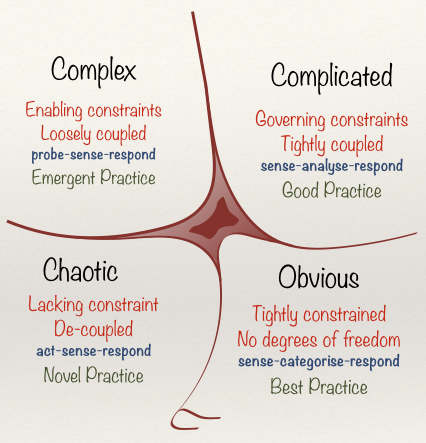Cynefin Framework
What is the Cynefin Framework?
Cynefin is a framework for problem solving and decision making. The word 'Cynefin' is Welsh and means habitat. It signifies “the multiple factors in our environment and our experience that influence us in ways we can never understand” (Snowden & Boone, 2007). The Cynefin framework was created by David Snowden when he worked at IBM Global Services in the early 2000’s and later as founder of Cognitive Edge. It has a basis in systems and complexity theory. Snowden describes it as “making sense of complexity in order to act.” The Cynefin framework categorizes any problem into one of the following five domains:
 Obvious: They are the “known knowns,” which means there are rules in place (best practices), the situation is stable, and the relationship between cause and effect is clear. The advice here is: “Sense (establish the facts) – Categorize – Respond (by following the rule)”.
Obvious: They are the “known knowns,” which means there are rules in place (best practices), the situation is stable, and the relationship between cause and effect is clear. The advice here is: “Sense (establish the facts) – Categorize – Respond (by following the rule)”.- Complicated. The “known unknowns.” There is a range of right answers so analysis and expertise are needed to understand the relationship between cause and effect. The framework recommends: “Sense – Analyze – Respond (with the appropriate good practice)”
- Complex. This domain represents the “unknown unknowns.” Cause and effect can only be perceived in retrospect, there are no right answers. Understanding the problem requires experimentation and investigation. The process here is: “Probe – Sense – Respond.”
- Chaotic. Cause and effect are unclear or there is no relationship between cause and effect at system level. The only way to respond is: “Act – Sense – Respond”: act to reduce damage and establish order, sense where stability lies and respond to turn the chaotic into the complex. The task of the manager is to stanch the bleeding first.
- Disorder / Confusion. These are situations where there is no clarity about which of the domains apply. The way out is to break down the situation in parts and assign each to one of the other domains. (This is the dark center of the image.)
The domains are not static and as knowledge increases, there is a “clockwise drift” from chaotic to complex and complicated to obvious. The opposite may happen too, when there is a “build-up of biases,” complacency (due to success), or lack of maintenance that can cause a clockwise movement, from obvious to chaotic. There can be a counter-clockwise movement when knowledge gets forgotten or new generations question the rules.
How Cynefin relates to Intelligent Swarming
Jon Stevens-Hall argues that swarm-based technical support can be organized around the principles of Cynefin. Looking at the different domains from a swarming perspective:
- Disorder: The nature of the issue is completely unknown. The Cynefin model suggests to break down the issue into parts, if possible, or as Stevens-Hall suggests, triage the issue into another domain.
- Obvious: Simple issues most likely can be solved by one knowledge worker and don’t need a swarm to be solved. If the issue happened before, ideally a knowledge article with the resolution will be present.
- Complicated: This issue is not straightforward to identify and resolve. Analysis is required. Depending on the experience of the knowledge worker, he or she can do this himself or request the aid of someone more experienced.
- Complex: For understanding and solving complex issues, experimentation is required (Probe, Sense, Respond). These issues are well suited for a swarming approach, because it will probably require different types of expertise to collect and analyze data regarding the issue.
- Chaotic: As stated before, the first step is to stop the bleeding and reduce further damage. This requires a swarm lead who can take action before taking steps to better understand the issue and move it into another domain (complex).
Resources
- The Cynefin Co (formerly known as Cognitive Edge). Please note that the Cynefin model is subject to an annual update. The 2021 update can be found on Dave Snowden's blog.
- Using Swarming to Deliver Cynefin in Tech Support by Jon Stevens-Hall
- Cynefin Framework on Wikipedia
- A Leader's Framework for Decision Making by David Snowden & Mary E. Boone (Harvard Business Review, November 2007)
